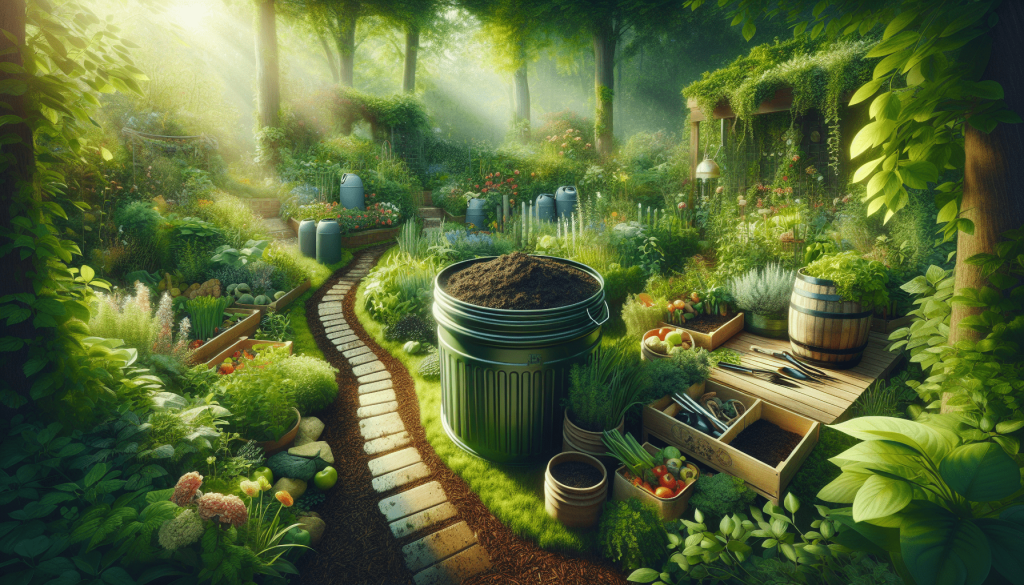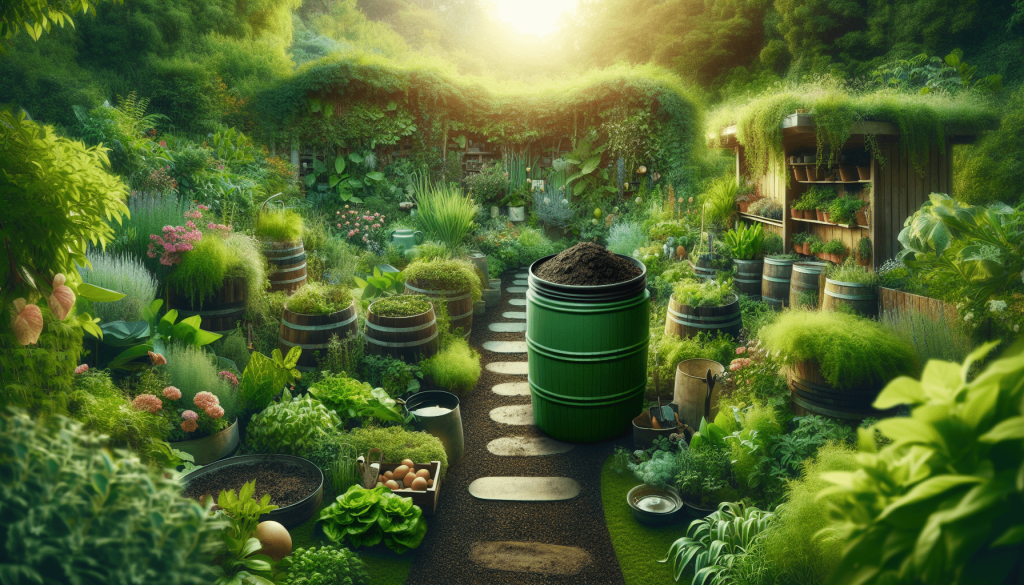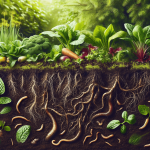This post may contain affiliate links. As an Amazon Associate, we may earn commissions from qualifying purchases.
Have you ever considered how much waste is generated from a typical garden? If you’re striving to make more environmentally conscious decisions, the idea of creating a zero-waste garden might just pique your interest. Crafting a garden that operates on zero-waste principles can be incredibly rewarding, both for your peace of mind and the planet. So, how do you create a zero-waste garden effectively and efficiently?

Understanding the Concept of a Zero-Waste Garden
Before you start, it’s important to wrap your head around what a zero-waste garden truly signifies. The philosophy rests upon minimizing waste by reducing, reusing, and recycling resources in your garden. It’s about creating a system where resources are utilized to their maximum potential, thereby preventing waste generation. This includes composting, using natural fertilizers, and even collecting rainwater. It’s a holistic approach that integrates sustainability into everyday gardening practices.
Why Choose a Zero-Waste Approach?
Adopting a zero-waste strategy can lead to numerous benefits. Not only does it help in conserving resources and energy, but it also fosters a healthier environment for your plants and the surrounding ecosystem. By reducing dependency on chemical fertilizers and pesticides, you’re supporting biodiversity and cultivating a more resilient garden opposed to traditional gardening methods.
Planning Your Zero-Waste Garden
The journey toward a zero-waste garden begins with a thoughtful plan. Think about what you want to achieve and how you can best utilize the resources at your disposal. Strategic planning will aid in maximizing the yield and minimizing waste.
Assess Your Space and Needs
Understanding the specifics of your outdoor space is crucial. Evaluate the available area, sunlight, soil type, and climate conditions, which will influence the types of plants you can grow and the gardening strategies you can employ. Also, consider your gardening goals — are you aiming to grow vegetables, herbs, or ornamental plants? All these factors will play a part in forming a sustainable garden plan.
Selecting the Right Plants
Choosing the appropriate plants for your garden is vital. Opt for native or perennial plants that require less maintenance and are better adapted to your local climate. These plants often need less water and fertilizer, making them an excellent choice for a zero-waste garden.
Designing for Efficiency
An efficient design can drastically minimize waste. Arrange your planting beds to maximize sunlight exposure and water usage. Group plants with similar needs together to enhance their growth and reduce resource consumption. Companion planting is an effective technique where certain plants are grown together for mutual benefits, such as pest control or enhanced growth.
Implementing Sustainable Water Practices
Water is an invaluable resource for any garden, and managing it sustainably is key to reducing waste. Implementing efficient water use strategies not only benefits the environment but also contributes to the healthy growth of your plants.
Collecting Rainwater
Installing a rainwater harvesting system is one of the most effective methods for conserving water. Collecting rainwater minimizes reliance on municipal water supplies and provides plants with chemical-free, fresh water.
Mulching for Moisture Retention
Using mulch in your garden helps retain soil moisture, reducing the need for frequent watering. Organic mulches such as straw, leaves, or grass clippings also add nutrients back into the soil as they decompose, contributing to a closed-loop system.
Sustainable Irrigation Methods
Drip irrigation systems and soaker hoses are more sustainable methods of watering your garden compared to traditional sprinklers. They deliver water directly to the base of the plants, reducing evaporation and ensuring that every drop counts.
Enhancing Soil Health Naturally
Healthy soil is the foundation of a thriving garden. Implementing natural methods to maintain and enhance soil fertility can significantly cut down on waste.
Composting Organic Waste
Composting is a cornerstone strategy for achieving zero waste. It involves recycling organic waste into nutrient-rich compost that can nourish your plants. Kitchen scraps, garden clippings, and even cardboard can all be composted, reducing the amount of waste sent to landfills.
Using Natural Fertilizers
Natural fertilizers, such as compost tea or manure, are pivotal in enriching your soil without the use of chemical products. These organic options release nutrients slowly, promoting healthier plant growth while reducing potential runoff pollution.
Implementing Crop Rotation
Crop rotation is a practice where different types of crops are planted sequentially in the same area. This tactic helps in balancing soil nutrients, reducing soil erosion, and minimizing pest and disease buildup.

Managing Pest and Disease Without Waste
Pest and disease management is another area where zero-waste principles can be applied. It’s about smart prevention and control methods that protect your garden without generating waste.
Encouraging Beneficial Insects
Promoting a thriving population of beneficial insects can help keep pest numbers in check naturally. Ladybugs, spiders, and bees are just a few examples of insects that contribute to a balanced ecosystem, reducing the need for chemical pesticides.
DIY Natural Pesticides
Creating your own natural pesticides from ingredients like garlic, neem oil, or chili can effectively combat pests without harming the environment. These solutions are simple to make and much less hazardous than synthetic counterparts.
Diverse Planting for Disease Control
Diversity in your garden can act as a natural deterrent to disease. By planting a variety of species, you reduce the risk of a single pest outbreak devastating your garden. Keeping your plants healthy through proper spacing and good air circulation also minimizes disease.
Recycling and Reusing in the Garden
Recycling and reusing resources is a fundamental component of a zero-waste strategy. By finding creative ways to repurpose materials, you reduce waste and conserve resources.
Upcycling Materials for Garden Use
Old containers, pallets, and even tires can find a new purpose in your garden. Upcycling keeps materials out of landfills and adds a unique personal touch to your green space.
Repurposing Kitchen Waste
Certain kitchen scraps, like eggshells or coffee grounds, can be reused directly in your garden. These materials can help deter pests, enrich the soil, and even alter acidity levels to suit particular plants.
Creating a Seed Bank
Saving seeds from your plants helps preserve plant genetics and reduces the need to buy new seeds each year. This simple act supports biodiversity and continues the cycle of life in your garden.
Educating Yourself and Your Community
The movement towards zero-waste gardening grows stronger when shared with others. Educating yourself continuously and sharing knowledge with your community can amplify the benefits.
Participating in Gardening Workshops
Attending or organizing gardening workshops can provide you with new insights and tips on sustainable practices. These events often foster a sense of community and are a great way to connect with like-minded individuals.
Sharing Excess Produce
If your garden produces more than you can consume, share the bounty with neighbors or donate to local food banks. This not only prevents food waste but also strengthens community ties.
Engaging in Community Gardens
Joining or starting a community garden is a fantastic opportunity to practice zero-waste gardening on a larger scale. It encourages cooperation, resource-sharing, and learning among diverse groups of people.
Measuring Your Zero-Waste Efforts
To ensure your zero-waste garden is thriving, take the time to measure the effectiveness of your strategies. Regularly assess how well you’re minimizing waste and maximizing productivity.
Keeping a Garden Journal
Maintaining a garden journal helps track your progress, note successful techniques, and identify areas for improvement. Document the seasons, weather patterns, plant growth stages, and yields to gain insights into how to optimize your garden.
Analyzing Waste Reduction
It’s useful to conduct a regular waste audit to see precisely what types of waste are being reduced. Categorize waste streams to highlight areas of success and improvement. This can also help you set new goals for your zero-waste efforts.
Continuous Improvement
Zero-waste gardening is a journey, not a destination. Always strive to improve your methods, adapt to changes, and innovate wherever possible. Embrace every small step as progress in contributing positively to the environment.
Conclusion
Creating a zero-waste garden requires a shift in mindset and routine, but it’s a rewarding endeavor that brings tangible benefits to you and the planet. By understanding the principles of zero waste and applying effective strategies, you can cultivate a garden that not only flourishes but also sets an example for sustainable living. Remember, every small effort counts towards making a significant impact on our environment. Happy gardening and may your endeavor inspire others to join you on the path to sustainability!








